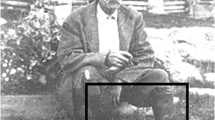Abstract
Clubfoot is one of the most common congenital orthopaedic anomalies and was described by Hippocrates in the year 400 BC. From manipulation in antiquity to splint and plaster in the Renaissance the treatment had improved before tenotomy. Tenotomy was tested during the 19th century and will be explained in this manuscript; the introduction of subcutaneous tenotomy of the Achilles tendon had focused the attention of surgeons on the surgical treatment of clubfeet. While this operation was very successful in the correction of equinus deformities due to poliomyelitis, cerebral palsy, and old injuries, it was not a panacea for the patient with the congenital clubfoot. To be successful, the forefoot adduction and inversion had to be corrected completely before correction of the equinus deformity could benefit the patient. For this reason operations were extended to include tenotomies of other tendons, particularly the anterior tibial tendon and incisions in the capsules of the talar joints.










Similar content being viewed by others
References
Hernigou P, Huys M, Pariat J, Jammal S (2017) History of clubfoot treatment, part I: From manipulation in antiquity to splint and plaster in Renaissance before tenotomy. Int Orthop. doi:10.1007/s00264-017-3487-1
Thilenius MG (1789) Medicinische und chirurgische Bemerkungen. Frankfurt am Main
Le Vay D (1976) Scenes from surgical life. Peter Owen, London
Michaelis CF (1811) Uber die Schwachung der Sehnen durch Einschneidung als einem Mittel bei manchen Gliederverunstaltungen. J Prakt Heilk Berlin 33(26, Part 11):4
Heister L (1719) Chirurgie. Nuremberg
Hernigou P (2016) Fathers of orthopaedics in Germany (eighteenth and early nineteenth centuries): Lorenz Heister in Helmsted; Johann Friedrich Dieffenbach in Berlin; Heine and family in Würzburg. Int Orthop 40(2):425–431
Sudhoff K (1922) Klassiker der Medizin. Leipzig
Molinelli PP (1745) De vulnerato AchiIlis tendinis. Comment Acad Sci Bonon 2:189
Hernigou P (2014) Bone transplantation and tissue engineering, part I. Mythology, miracles and fantasy: from chimera to the miracle of the black leg of saints Cosmas and Damian and the cock of John hunter. Int Orthop 38(12):2631–2638
Ottley D (1835) The Life of John Hunter, F.KS. In The Works of John Hunter, F.R.S. (Ed) James F. Palmer London: Longman, Rees, Orme, Brown, Green and Longmans, 1:33-34
Bromfield W (1773) Chirurgical observations and cases. London
Delpech JM (1816) Precis elementaire des maladies reputees chirurgicales. Paris
Delpech JM (1828) Chirurgie clinique de Montpellier, vol. II, pp 177 and 231, Paris and Montpellier
Delpech JM (1828) De I’Orthomorphie, vol n. Gabon, Paris, p 328
Delpech JM (1815) Memoire sur la complication desplaies et des ulceres connue sous le nom de pourriture d ‘hopital. Mequignonet Marvis, Paris
Wangensteen OH, Wangensteen SD (1978) The rise of surgery from empiric craft to scientific discipline. University of Minnesota Press, Minneapolis
Delpech (1823) Chirurgie clinique de Montpellier; ou, observations et reflexions tirees des travaux de chirurgie clinique de cette ecole Paris et Montpellier. Gabon et Cie 1:147–231
Stromeyer L (1833) Die Durchschneidung des Achillessehne, als Heilmethode des Klumpfusses, durch zwei Falle erlautert. Mag. ges. Hielk. (Rust) 39(NF15):195
Hernigou P (2016) Authorities and foundation of an orthopaedic school in Germany in the nineteenth century: Part I: Conrad Johann Martin Langenbeck; Georg Friedrich Louis Stromeyer; Bernhard Rudolf Conrad von Langenbeck; Johann Friedrich August von Esmarch. Int Orthop 40(3):633–640
Stromeyer L (1834) Arch. Gen. MM
Stromeyer (1838) Beitrage zur operativen Orthopddik. Helwing, Hanover
Little WJ (1839) A treatise on the nature of club-foot and analogous distortions; including their treatment both with and without surgical operation. Longman, Brown, Green, and Longmans, London
Little WJ (1853) On the nature and treatment of deformities of the human frame. London
Gibney VP (1912) Reminiscences of the orthopaedic surgeons of the latter half of the 19th century. N.Y. Med I(95):913
Adams W (1871) Club-foot: its causes, pathology and treatment. London
Sayre LA (1876) Lectures on orthopedic surgery and diseases of the joints. New York
Muetter TD (1839) A lecture on coxarthrosis, or club foot. Philadephia
Detmold WL (1840) An essay on club-foot and some analogous diseases. New York
Cohen J (1958) The Boston Orthopedic Institution. J Bone Joint Surg 40A:1176–1178
Scoutteten H (1839) Ueber radicale Heilung der Klumpfiisse, trans. W. Walther. Leopold Michelsen, Leipzig
Stewart FC (1843) The hospitals and surgeons of Paris. J. & H. Langley, New York, pp 295–300
Guérin J (1857) Institut orthopédique de la Muette pour le traitement des difformités de la taille et des membres chez les personnes des deux sexes, Édition: Paris. Impr. de A. Éverat
Mott V (1842) Travels in Europe and the East. Harper & Brothers, New York, p 55
Peltier (1983) Guerin versus Malgaigne: a precedent for the free criticism of scientific papers. J Orthop Res 1:115–118
Patel M (1955) Amedee Bonnet (1809–1858). Prog Med 83:287–290
Bonnet (1841) Traite des sections tendoneuses et musculaires. Charles Savy Jeune, Lyon
Flaubert G (1857) Madame Bovary. Mœurs de province (Michel Lévy frères)
Author information
Authors and Affiliations
Corresponding author
Ethics declarations
Conflict of interest
The authors declare that they have no conflict of interest.
Funding
There is no funding source.
Rights and permissions
About this article
Cite this article
Hernigou, P., Gravina, N., Potage, D. et al. History of club-foot treatment; part II: tenotomy in the nineteenth century. International Orthopaedics (SICOT) 41, 2205–2212 (2017). https://doi.org/10.1007/s00264-017-3578-z
Received:
Accepted:
Published:
Issue Date:
DOI: https://doi.org/10.1007/s00264-017-3578-z




